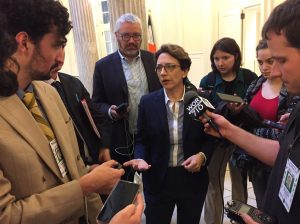DOT, NYPD Open to Bill Allowing Cyclists to Proceed on LPIs
With the LPI bill, we legalize a practice that many cyclists already utilize to stay visible. It also makes clear: cyclists aren’t cars. pic.twitter.com/81PwC4B6vo
— Ydanis Rodriguez (@ydanis) November 15, 2016
The City Council transportation committee heard testimony today concerning a package of bike and pedestrian safety bills, including one that would allow cyclists to follow pedestrian signals instead of car signals.
Intro 1072, introduced by Council Member Carlos Menchaca, would improve safety at intersections by making it legal for cyclists to proceed during leading pedestrian intervals — the head start that pedestrians receive at some crossings. People on bikes routinely follow LPI signals to avoid conflicts with motorists.
Turning drivers caused nearly a fourth of cyclist deaths at intersections between 2006 and 2014, according to city crash data. The bill highlights that both pedestrians and cyclists are “extremely vulnerable to turning cars at intersections,” said committee chair Ydanis Rodriguez.
Menchaca said the bill preserves the pedestrian right of way and codifies the way many people already ride, following their instinct to get a head start and be visible to drivers before the light turns green. “Cyclists know what they’re doing,” Menchaca said.
The city will have 1,500 LPIs online by the end of the year, mostly at intersections that see a high number of crashes, said DOT Director of Bike and Pedestrian Programs Sean Quinn. DOT “supports the intent” of the LPI bill, Quinn said, and wants to adjust it to allow for exemptions to be made at “select instances, such as exclusive pedestrian phases or locations with complicated geometries,” where DOT deems the cyclist head start to be unsafe.
NYPD Inspector Dennis Fulton told council members the department may run into problems training officers on how to apply the law because it draws a distinction between cyclists and drivers. However, Fulton said NYPD is open to working with the council to refine the bill as necessary.
During public testimony, Transportation Alternatives Policy and Research Manager Julia Kite said similar legislation has been in place in the District of Columbia since 2013. Kite noted that motorist-on-pedestrian collisions are down by 60 percent at NYC intersections with leading pedestrian intervals, and said comparable safety gains for cyclists could be expected.
The LPI bill would make it easier for people on bikes to stay out of truck drivers’ blind spots, said Kite. As it is, she said, many cyclists are hit by drivers while following the law.
Mary Beth Kelly, a founding member of Families for Safe Streets, told council members that allowing cyclists to follow pedestrian signals could have saved the life of her husband, Dr. Carl Henry Nacht, who was struck by a turning NYPD truck driver as the couple rode their bikes on the Hudson River Greenway in June 2006.
Likening the measure to a vaccine, Kite said, “Why aren’t we using it? We know it will work.”
Intro 1285, a Rodriguez bill to require DOT to study the 10 most crowded sidewalks in NYC and explore solutions to overcrowding, did not get DOT’s support. According to Quinn, DOT has no way to accurately measure pedestrian volumes. Quinn said widening sidewalks would hamper buses and bikes.
On Twitter, Rodriguez responded: “The bill doesn’t call for [a] one size fits all solution and gives discretion to DOT to make a call that works or no call at all. We know where the most crowded sidewalks are… [People are] pushed into roadbed due to crowding. Important to take action.”
DOT also declined to support a bill from Rodriguez and Helen Rosenthal to require the agency to examine the feasibility of more Barnes Dance crossings. Instead, said Quinn, DOT is trying out measures including LPIs and slowing left-hand turns.
DOT was not receptive to a Menchaca bill to require the Parks Department and DOT to study the feasibility of placing Citi Bike stations in parks. Citi Bike is primarily used for transportation, not recreation, Quinn said, and bike-share is available 24 hours a day while parks are not.
The committee approved a bill, introduced by Rodriguez and Costa Constantinides, to create a pilot program that would place charging stations for electric cars in each borough.
Correction: This post originally stated that DOT opposed codifying the cyclist head start on LPIs and wanted to evaluate it on a case-by-case basis. That was incorrect. DOT’s testimony supported the law, on the condition that it be amended to allow for specific exemptions to the cyclist head start, at locations determined by DOT.
